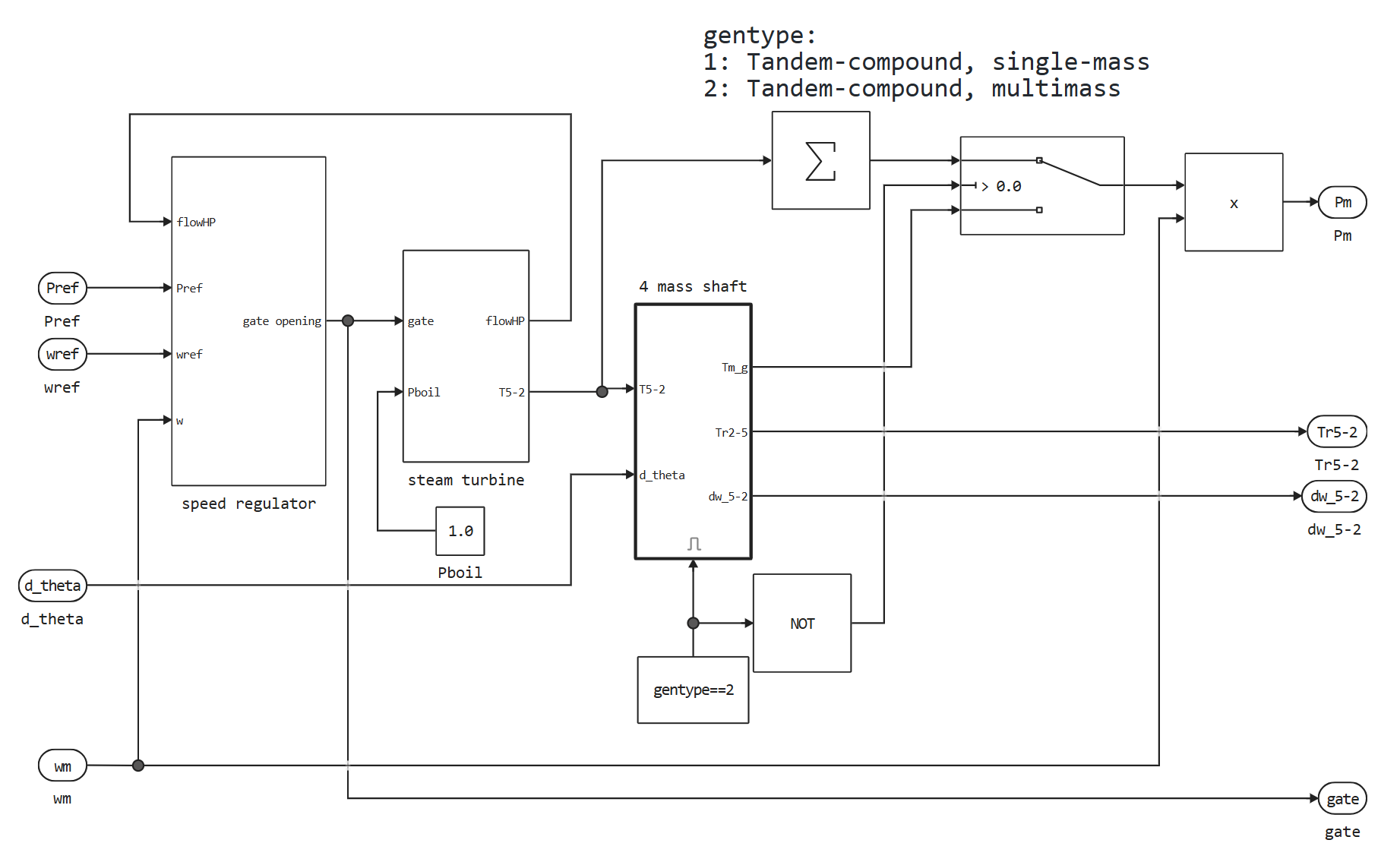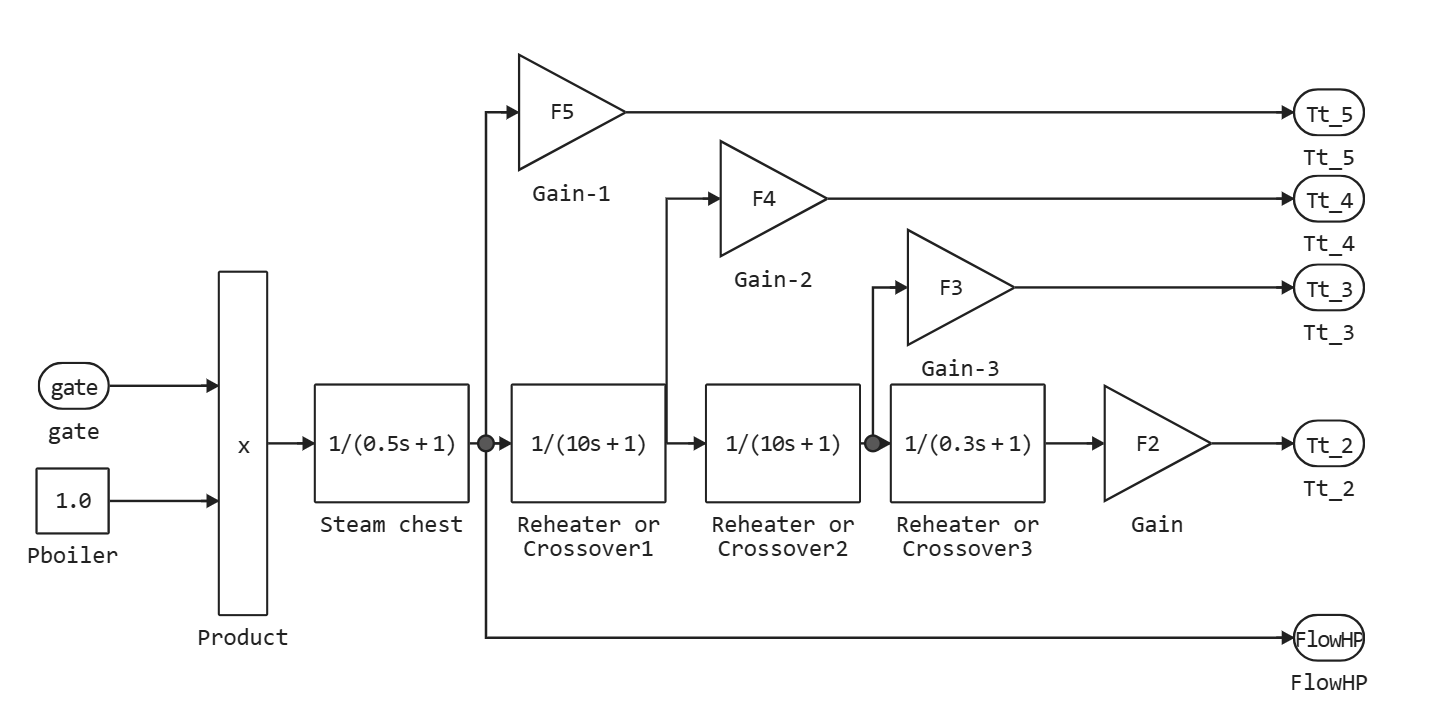Steam Turbine and Governor
Model of speed control system, steam turbine and shafting system.
blockType: SubSystem
Path in the library: |
Description
The Steam Turbine and Governor unit realises a single-shaft multi-cylinder steam turbine unit including speed control system, four-stage steam turbine and four-rotor shafting.

The speed control system consists of a P-regulator, a speed relay and a servo actuator controlling the gate opening.

The steam turbine consists of four stages, each modelled by a first order transfer function. The first stage represents the steam boiler, while the other three stages represent either regenerative heaters or cross pipework. The boiler is not modelled, the boiler pressure is constant at 1 o.u. The turbine torque coefficients (fractions) are used to distribute the turbine power between the different stages of the shafting.

The shaft line models a system of four masses which is coupled to a mass in the synchronous machine model, giving a total of five masses. The mass of the machine is labelled mass 1. The mass in the steam turbine and regulator assembly that is closest to the machine mass is mass 2, and the mass furthest from the machine is mass 5. The shafting is characterised by mass inertia , damping coefficients and stiffness coefficients . If a single mass shafting system is to be modelled, the entire shafting subsystem of the four masses in the steam turbine and regulator assembly will be disconnected and all torque from the turbine will be summed and applied to the machine mass.
Ports
Input
#
ωref
—
speed setpoint
scalar
Details
Reference speed in relative units. Normally connected to the Constant block with a value of 1.0.
| Data types |
|
| Complex numbers support |
No |
#
Pref
—
mechanical power setpoint
scalar
Details
Reference mechanical power in relative units. Set to a constant value corresponding to the initial active power drawn from the synchronous machine unit connected to the steam turbine and regulator unit.
| Data types |
|
| Complex numbers support |
No |
#
ωm
—
generator speed
scalar
Details
The speed of the oscillator in relative units. This is one of the signals in the last output of the synchronous machine model.
| Data types |
|
| Complex numbers support |
No |
#
Δθ
—
angular deviation of generator power
scalar
Details
The angular deviation of the generator power. This is also one of the signals at the last output of the synchronous machine model.
| Data types |
|
| Complex numbers support |
No |
Output
#
Δω5-2
—
mass velocity deviation
vector
Details
Deviation of the velocity of masses 5, 4, 3 and 2 in relative units.
| Data types |
|
| Complex numbers support |
No |
#
Tr5-2
—
electromagnetic moments transmitted to the masses
`vector'
Details
Electromagnetic moments in relative units imparted by masses 5, 4, 3 and 2.
| Data types |
|
| Complex numbers support |
No |
#
gate
—
gate opening
scalar
Details
Shutter opening in relative units.
| Data types |
|
| Complex numbers support |
No |
#
Pm
—
mechanical power
scalar
Details
Mechanical power for the Synchronous Machine unit in relative units.
| Data types |
|
| Complex numbers support |
No |
Parameters
Main
#
Generator type —
rotor type
Tandem-Compound (single mass) | Tandem-Compound (multi-mass)
Details
Rotor type: single-mass or multi-mass single-shaft multi-cylinder.
If a single mass system is selected, the multi-mass shaft subsystem in the Steam Turbine and Governor block is switched off and the turbine torques are summed and applied to the single mass system in the Synchronous Machine block.
| Values |
|
| Default value |
|
| Program usage name |
|
| Evaluatable |
Yes |
# Regulator gain, perm. droop, dead zone [Kp Rp(pu) Dz(pu)] — amplification factor, statism factor and dead band width
Details
Gain factor , constant decay in relative units and deadband width in relative units. Set the gain to 3 if you want to use a vapour flow feedback loop. Otherwise, set the value to 1.
| Default value |
|
| Program usage name |
|
| Evaluatable |
Yes |
# Speed relay and servo-motor time constants [Tsr Tsm], s — time constants of the speed relay and gate servo drive
Details
Time constants of speed relay and shutter servo motor in seconds.
| Default value |
|
| Program usage name |
|
| Evaluatable |
Yes |
# Gate opening limits [vgmin(pu/s) vgmax(pu/s) gmin(pu) gmax(pu)] — shutter opening limits
Details
Minimum and maximum shutter opening speed and in relative units per second, and minimum and maximum shutter opening and in relative units.
| Default value |
|
| Program usage name |
|
| Evaluatable |
Yes |
# Nominal speed of synchronous machine, rpm — synchronous generator speed
Details
Synchronous speed of a generator in rpm driven by a steam turbine.
| Default value |
|
| Program usage name |
|
| Evaluatable |
Yes |
# Steam turbine time constants [T2 T3 T4 T5], s — turbine time constants
Details
Turbine time constants from to in seconds. Numbered sequentially with turbine torque fraction and mass number, e.g. — the time constant of the first stage of the turbine, which simulates a steam chamber.
| Default value |
|
| Program usage name |
|
| Evaluatable |
Yes |
# Turbine torque fractions [F2 F3 F4 F5] — turbine torque fractions
Details
Turbine torque fractions from to . The sum of the elements of this vector must be equal to 1, otherwise an error message will appear. The fraction numbers correspond to the mass numbers, i.e. is the fraction of torque applied to mass 2 of the multi-mass shaft.
| Default value |
|
| Program usage name |
|
| Evaluatable |
Yes |
# Coeff. of inertia [H2 H3 H4 H5], s — inertia coefficients
Details
The coefficients of inertia from to in seconds are related to the masses of the multi-mass shaft.
Dependencies
To use this parameter, set the Generator type parameter to Tandem-compound (multi-mass).
| Default value |
|
| Program usage name |
|
| Evaluatable |
Yes |
# Stiffness coeff. [K12 K23 K34 K45], pu/rad — stiffness coefficients
Details
Stiffness coefficients from to in relative units per radian related to the masses of the multi-mass shaft, i.e. corresponds to the stiffness coefficient between masses 1 and 2 and so on.
Dependencies
To use this parameter, set the Generator type parameter to Tandem-compound (multi-mass).
| Default value |
|
| Program usage name |
|
| Evaluatable |
Yes |
# Damping factors [D2 D3 D4 D5], pu_T/pu_dw — damping factors
Details
Damping factors from to , defined as the ratio of torque in relative units and speed deviation in relative units, related to the masses of a multi-mass shaft.
Dependencies
To use this parameter, set the Generator type parameter to Tandem-compound (multi-mass).
| Default value |
|
| Program usage name |
|
| Evaluatable |
Yes |
Initial Values
# Initial power and generator rotor angle [Pm0(pu) th0(deg)] — initial mechanical power and initial generator rotation angle
Details
Initial mechanical power in relative units and initial generator rotation angle in degrees.
Dependencies
To use this parameter, set the Generator type parameter to Tandem-compound (multi-mass).
| Default value |
|
| Program usage name |
|
| Evaluatable |
Yes |
Literature
[1] IEEE committee report, "Dynamic models for steam and hydro turbines in power system studies," IEEE Transactions on Power Apparatus and Systems, Vol. PAS-92, No. 6, 1973, pp. 1904-1915.
[2] IEEE Subsynchronous resonance working group, "Second benchmark model for computer simulation of subsynchronous resonance," IEEE Transactions on Power Apparatus and Systems, Vol. PAS-104, No. 5, 1985, pp. 1057-1066.
